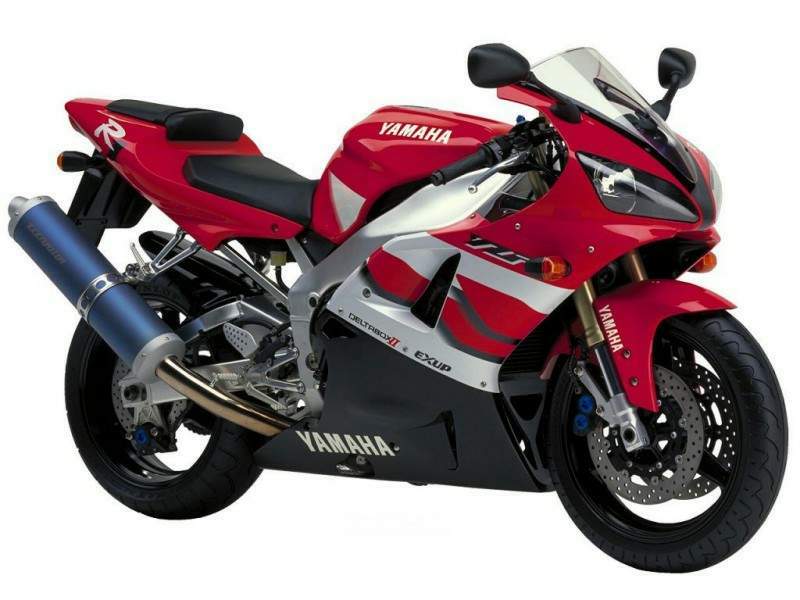|
Make Model |
Yamaha YZF1000 R1 |
|
Year |
2000 |
|
Engine |
Four stroke, transverse four cylinder, DOHC, 5 valves per cylinder. |
|
Capacity |
998 cc / 60.9 cu-in |
| Bore x Stroke | 74 x 58 mm |
| Compression Ratio | 11.8:1 |
| Cooling System | Liquid cooled |
| Lubrication | Wet sump |
| Engine Oil | Mineral, 20W/40 |
| Exhaust | Alloy muffler |
|
Induction |
4 x 40mm Mikuni CV Downdraft carbs |
|
Ignition |
Digital TCI |
| Spark Plug | NGK, CR9E |
| Starting | Electric |
| Additional |
Engine weight 65.3kg 17mm diameter gudgeons |
|
Max Power |
148.8 hp / 109.5 kW @ 10000 rpm |
| Rear Tyre Power | 138.8 hp @ 9600 rpm |
|
Max Torque |
11.0 kgf-m / 108.3 Nm @ 8500 rpm |
| Clutch | Wet, multiple discs, cable operated |
|
Transmission |
6 Speed |
| Final Drive | Chain |
| Gear Ratio | 1st 39/15 (2.600) 2nd 35/19 (1.842) 3rd 30/20 (1.500) 4th 28/21 (1.333) 5th 30/25 (1.200) 6th 29/26 (1.115) |
| Frame | Aluminium, twin spar |
|
Front Suspension |
41mm inverted telescopic forks |
| Rear Wheel Travel | 135 mm / 5.3 in |
|
Rear Suspension |
Truss-type Aluminium swinging arm Monocross system |
| Rear Wheel Travel | 130 mm / 5.1 in |
|
Front Brakes |
2 x 298mm discs 4 piston calipers |
|
Rear Brakes |
Single 256mm disc 2 piston caliper |
| Rim Front | 3.50-17 |
| Rim Rear | 6.00-17 |
|
Front Tyre |
120/70 ZR17 |
|
Rear Tyre |
190/50 ZR17 |
| Rake | 24° |
| Trail | 91 mm / 3.8 in |
| Dimensions |
Length 2035 mm / 80.1 in Width 695 mm / 27.3 in Height 1095 mm / 43.1 in |
| Wheelbase | 1395 mm / 54.9 in |
| Ground Clearance | 140 mm / 5.5 in |
| Seat Height | 813 mm / 32.3 in |
|
Dry Weight |
177 kg / 390.2 lbs |
| Wet Weight | 192 kg / 423 lbs |
|
Fuel Capacity |
18 Litres / 4.7 gal |
|
Consumption Average |
17.2 km/lit |
|
Braking 60 - 0 / 100 - 0 |
12.7 m / 36.7 m |
|
Standing ¼ Mile |
10.3 sec / 222.7 km/h |
|
Top Speed |
277.2 km/h / 172.2 mph |
|
Road Test |
Supetbke Group Test 2000 |
| . |
In 2000, Yamaha introduced a series of changes to improve the bike, and minor changes to the bodywork to allow for better long duration ride handling. Yamaha's main design goal was to sharpen the pre-existing bike and not to redesign it. The dry weight was reduced five pounds to 414 lb (188 kg).
At 127.8 hp (95.3 kW) at the rear wheel, top-end output remained the same, but changes to the engine management system were intended to result in a smoother, broader distribution of power. The bodywork was still unmistakably R1, although a few changes were made resulting in a 3% reduction in the drag coefficient. The headlight housing's profile was sharpened, the side panels were made more aerodynamic and slippery, and the windscreen was reshaped for better rider protection.
The seating area was also updated. The fuel tank was reshaped, with a more relaxed rear angle and deeper leg recesses to provide for a better rider feel. The seat extended further towards the rear of the tank and the new, steeper, seating position put additional weight on the front end. All of this was aimed at improving weight bias and offering sharper cornering and more stability.
Mechanically, the carburetors were re-jetted in an effort to improve throttle response, especially in the low end, all the way up to the bike's 11,750 rpm redline. The redesigned camshafts were lightened and used internal oil ways to lubricate journals that, when combined with reduced tappet clearance, provided less friction and created less engine noise. The gearbox received a taller first gear, a hollow chrome moly shift shaft with an additional bearing and a completely redesigned shift linkage and foot pedal. These changes were aimed at eliminating problems with the transmission in earlier models, and to help to seamlessly transfer the bike's power to the road.
2000-2001
In 2000, Yamaha introduced a series of changes to improve the bike, and minor changes to the bodywork to allow for better long duration ride handling. Yamaha's main design goal was to sharpen the pre-existing bike and not to redesign it. Even so they instituted over 150 changes in hopes of making an already light, sleek motorcycle even lighter and sleeker. For example, even with the addition of the new air induction system, which weighed four pounds, the overall weight of the bike was down five pounds to 414 lb (188 kg) dry.
At 127.8 bhp (95.3 kW) at the rear wheel,[7] top-end output remained the same, but changes to the engine management system were intended to result in a smoother, broader distribution of power. The bodywork was still unmistakably R1, although a few changes were made resulting in a 3% reduction in the drag coefficient. The headlight housing's profile was sharpened, the side panels were made more aerodynamic and slippery, and the windscreen was reshaped for better rider protection. These redesigns changed the bodywork to a large enough degree that previous years' bodywork will not fit the 2000 model.
The seating area was also updated. The fuel tank was reshaped, with a more relaxed rear angle and deeper leg recesses to provide for a better rider feel. The seat extended further towards the front of the tank and the new, steeper, seating position put additional weight on the front end. All of this was aimed at improving weight bias and offering sharper cornering and more stability.
Mechanically, the carburetors were re-jetted in an effort to improve throttle response, especially in the low end, all the way up to the bike's 11,750 rpm redline. The redesigned camshafts were lightened and used internal oil ways to lubricate journals that, when combined with reduced tappet clearance, provided less friction and created less engine noise. The gearbox received a taller first gear, a hollow chrome-moly shift-shaft with an additional bearing and a completely redesigned shift linkage and foot pedal. These changes were aimed at eliminating problems with the transmission in earlier models, and to help to seamlessly transfer the R1's power to the tarmac.
Source wikipedia
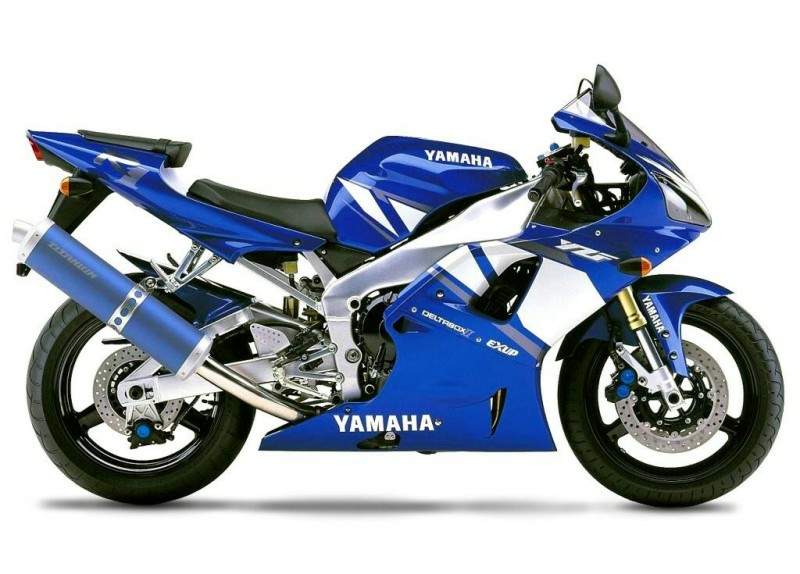
Review
Valencia, Spain, December 20, 1999 -- We could write this review in one sentence: The Year 2000 Yamaha YZF-R1 is an awesome motorcycle.
Although that's about all most people need to hear, we feel
we owe it to Yamaha and a few pesky readers to extrapolate a
bit with more detail. Sure, we'd rather you take our word so
we can turn off our computers and go riding, but in the
interest of professional journalism we'll park our bikes, take
off our helmets and fire off a few more words on what is
basically a great motorcycle.
To understand the YZF-R1's place within the motorcycle
universe, a short history lesson is in order. When Yamaha's
YZF1000 debuted in 1996, the world's motorcycling press
wondered, as spot-on as that bike was, how open-class
motorcycles could become any better. The YZF1000 did
everything right and nothing wrong. It had a brawny motor, a
solid and well-balanced chassis, a dialed-in suspension and
fantastic brakes. Even so, in 1998 Yamaha unveiled the R1 on
an unsuspecting world and changed the perception of the limits
of open-class supersport motorcycles.
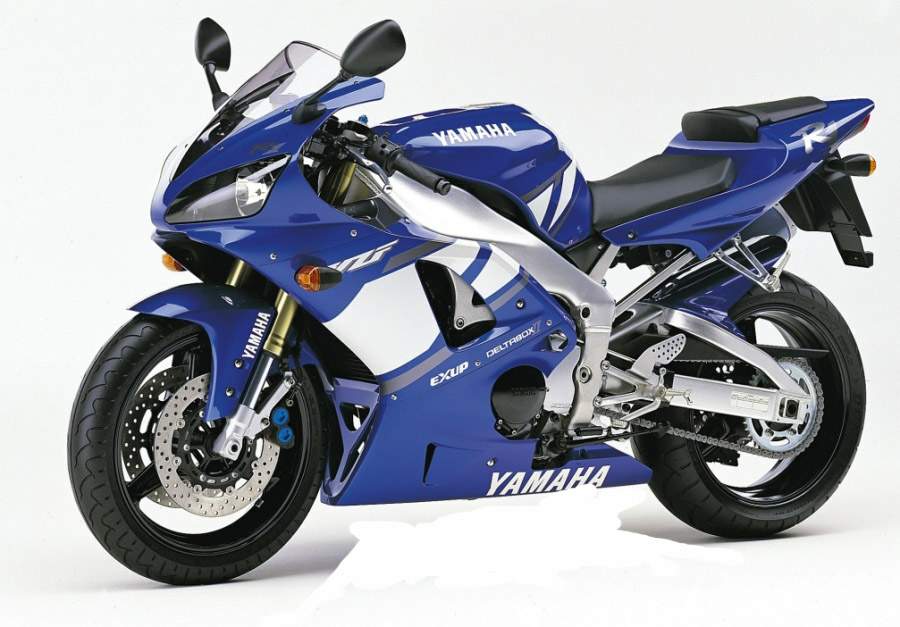
The competition's open-class bikes available were geared, quite literally, more for top-speed honors and back-up sport-touring duties. But the Yamaha YZF-R1 changed the rules by successfully combining the awesome power available previously in open-class size with the lightweight and responsiveness that a 600-class chassis affords. Honda tried this with the CBR900RR and although they arguably created the modern liter-bike supersport class by pushing beyond the previous heights of the Suzuki GSX-R1100, it was, by no means mechanically nor stylistically, the quantum leap forward the R1 made.
Thus Yamaha permanently altered the sportbike landscape. Yet when we heard they would hold a world press introduction for the Year 2000 R1, we wondered why they would go to such lengths. Could Yamaha have altered an already revolutionary motorcycle so much and soon to justify an expensive undertaking such as a worldwide press intro? Perhaps Yamaha was concerned about the notoriously short-attention span of the industry press and, with the upcoming challenge from Honda's all-new CBR929RR, they wanted to maintain the R1's position as the top-of-mind cutting-edge sportbike among enthusiasts and the motorcycle press. Or perhaps Yamaha did indeed make one of the best sport motorcycles even better. Of course we weren't complaining, we simply wouldn't know until Spain. New Life Nothing of mechanical importance in this shot. Just a cool, post-industrial, minimalist kind-of-looking pic. When refurbishing the YZF-R1 for the Year 2000, Yamaha's main design goal was to sharpen the pre-existing bike and not redesign it. Even so they instituted over 150 changes in hopes of making an already light, sleek and mean motorcycle even lighter, sleeker and meaner.
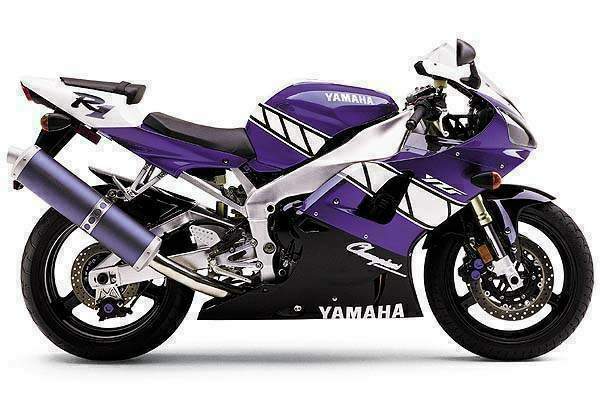
For example, even with the addition of the new Air Induction System, which weighs four pounds, the overall weight of the bike is down five pounds to a claimed 385 pounds dry. At a claimed 150 horsepower at the crank, top-end output remains the same but changes to the engine management system are supposed to result in a smoother, broader distribution of power.
The bodywork is still unmistakably R1 although a few changes were made resulting in a 3% reduction in the drag coefficient. The headlight housing has a sharper profile, the side panels are more aerodynamic and slippery and the windscreen has been reshaped for better rider protection. In fact the bodywork changed so much that bodywork from previous R1s will not fit the Y2K edition.
Also updated is the seating area. The fuel tank is reshaped with a more relaxed rear angle and deeper leg recesses to provide for better rider feel. The seat extends further towards the front of the tank and the new, steeper seating position puts additional weight on the front end. All of this is aimed at improving weight bias and offering sharper cornering and more stability. Again, the resounding theme here is to sharpen what was already a very sharp package.
Performance wise, Yamaha claims the year 2000 R1 provides improved aspiration, smoother shifting and better lubrication. The motor is equipped with Yamaha's new Air Induction System (AIS) that works off of crankcase pressure and a bladder-type device to pump air into the exhaust port after the mixture has been combusted. The Air Induction System will be found on all bikes worldwide and for track use it can be removed and the holes plugged. Reportedly this will not hinder performance.
The carburetors have been rejetted in an effort to improve throttle response -- especially in the low end -- all the way up to the bike's 11,750 rpm redline. The redesigned camshafts are lighter and use internal oilways to lubricate journals that, when combined with reduced tapped clearance, provide less friction and create less engine noise. Also changed within the crankcase is the gearbox featuring a taller first gear, a hollow chrome-moly shift-shaft with an additional bearing and a completely redesigned shift linkage and foot pedal. These changes are aimed at nixing last year's transmission complaints as well as helping to transfer as seamlessly as possible the R1's prodigious power to the pavement.
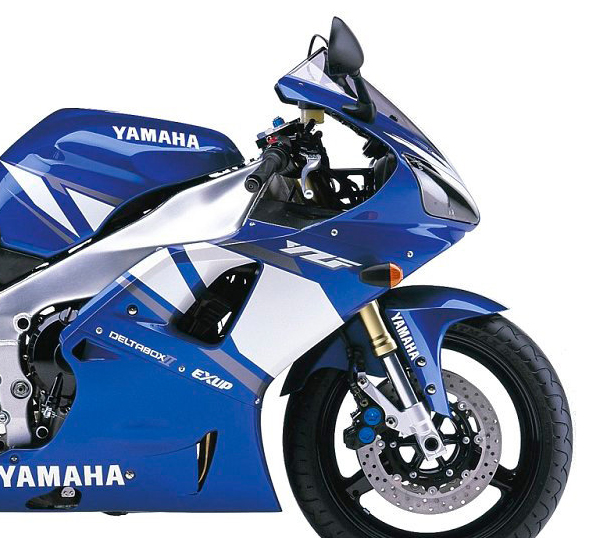
Immediately we noticed that the shifting was improved significantly.
The notchy action found on earlier bikes was gone. On the
Year 2000 YZF-R1 the formerly clunky shift from first to
second gear was now no more abrupt than a shift from third to
fourth at moderate speeds. It's silky smooth, and the rest of
the cogs meshed even better. The clutch still retains the same
great action as on earlier models and it didn't exhibit any
grabbiness.
Once we began circulating the track at elevated speeds, a
typical R1-thing happened. When we came out of a second-gear
left hand corner we noticed that while we were heading left
the front end was aimed right. The abundant power is so smooth
and seamless we didn't notice the front end lift. When we
grabbed third gear after a seamless, clutchless up-shift and
the front end returned to the tarmac, we felt only a minor
flutter of the handlebars.
When most other bikes begin to twitch, the shakes get worse
before the front end straightens out. With the R1, the front
end regains its composure quickly because the chassis is so
solid and the steering is so neutral. The front-end flutter
soon faded and before we knew it we were braking into the next
corner, where we learned that the dual four-pot calipers,
generally regarded as the best in the business, are even
better. The pads are new, the disc bracket is thinner and the
number of rotor pins has been reduced from 10 to 8, all of
which help to minimize front-end dive and provide for an even
more progressive feedback.
Not once did we wish for more power or better handling. Even
though the motor wailed up to the point where the rev limiter
kicked in, we found the best results were garnered by shifting
a few hundred rpm shy of redline. The only bad traits we
uncovered could be traced to the special R1-spec Dunlop
D207-ZRs. As good as street tires the ZRs may be, they are not
ideal for track duty, and on the R1 we would have preferred
the new 207-GP Stars. Still, the tires gripped the track
sufficiently and the sound of footpegs dragging mid-corner was
heard all day. Ground Clearance remains ample and only at Rich
Oliver's cornering speeds did hard parts scrape, and even then
he only nicked the blue exhaust can.
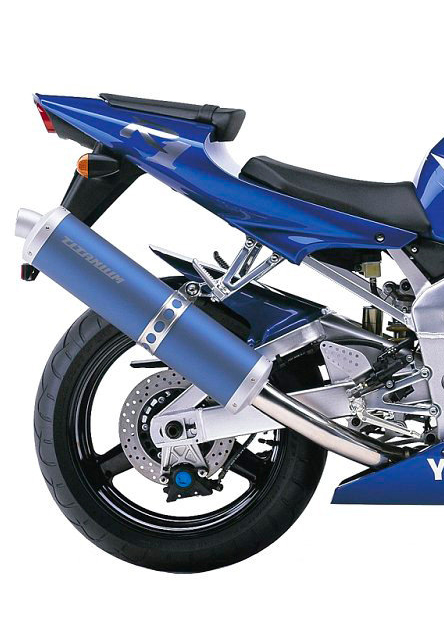
The track was ice-rink smooth with zero pavement seams and
only one minor mid-corner bump, so it was tough to grade the
suspension for mid-corner bump absorption. That would have to
wait for the 500 kilometer ride across twisty Spanish back
roads and through picturesque towns. Only on the return road
would we encounter a long stretch of straight highway.
With suspension settings returned to stock, we headed into the hills. The motor that was such a potent screamer at the track proved to be more than willing around town as well. The R1 still possesses gobs of torque and midrange power and the machine pulls cleanly from as low as 2000 rpm. The quiet titanium muffler didn't seem to disturb residents and we didn't have to over-rev the bike in first or lug it in second through the tight streets because the taller gearing did not necessitate an inordinate amount of clutch slip.
On a wet mountain road a few riders pussy-footed along
because they feared the R1 would suddenly decide mid-corner to
make 50% more power and toss its pilot. However, the new
carburetion changes kept the R1 tractable, although without
riding last year's R1, it's tough to say whether or not
there's any significant improvement. Still, we quickly learned
to trust the bike and as speeds increased our comfort levels
rose correspondingly.
When the pavement was dry and we found ourselves alone on the
twisty roads, the speeds soon came up to stupid levels because
our track day gave us an abundance of confidence. Even though
the first R1s were well-sprung, the new valving in the forks
combined with the lighter-for-2000 rear shock offer a
compliant ride across all surface conditions while keeping the
bike composed at truly rapid speeds.
Yamaha has achieved their goal of creating a bike that
feels sharper. The bike has a seemingly perfect balance of
brute power and rideability coupled with track-worthy
suspension that, with just a few clicks, becomes compatible
with city streets and country roads. Few bikes achieve this
even after significant and expensive aftermarket upgrades.
Still, without riding last year's bike, it is hard to tell how
much better the new R1 is. It's our initial impression that
the Year 2000 Yamaha YZF-R1 is a better, crisper supersport
motorcycle.
With the Y2K YZF-R1 Yamaha has upped the ante and forced the
competition to aim at what their press literature calls a
"moving target." This model year other manufacturers will
offer either all-new or significantly tweaked open-class
supersports, so the question remains: Can the new R1 maintain
its position as the open-class supersport
motorcycle? We're anxious to see what happens when we ride
the open-class supersport bikes together. Has Yamaha done
enough homework to satiate its current customers and acquire
new ones who may be holding on to their deposit money until
back-to-back comparisons of all three bikes take place and one
bike stands above the rest? Stay tuned?
Source Motorcycle Daily

